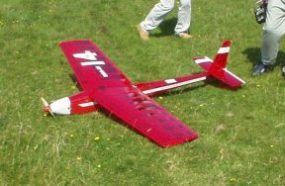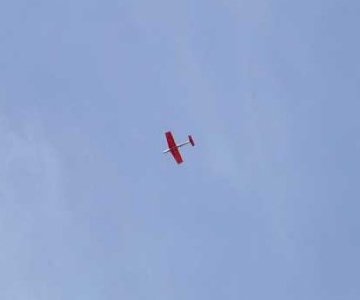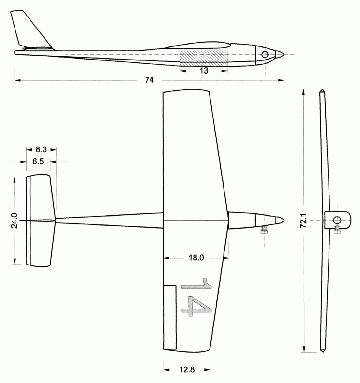Model Plane Flies the Atlantic
A historic flight takes an 11-pound model airplane over the ocean.
By Emily Sohn
When Maynard Hill decided he wanted to fly a model airplane across the Atlantic Ocean, no one took him seriously.
“To be perfectly honest, most of us thought he was crazy,” says Dave Brown, president of the Academy of Model Aeronautics and an old friend of Hill’s. “We didn’t think it could be done.”
Sometimes, daring to be crazy pays off. Last summer, one of Hill’s creations became the first model airplane to cross the Atlantic.
 |
|
TAM-5, the model airplane that crossed the Atlantic Ocean, rests at its landing spot in Ireland.
|
| Ronan Coyne |
Named TAM-5, the 11-pound plane flew 1,888 miles from Canada to Ireland in 38 hours, 53 minutes. It set world records for longest distance and longest time ever flown by a model airplane.
The achievement came at a symbolic time in the history of flight. One hundred years ago, on Dec. 17, 1903, the Wright brothers made the first powered, sustained, and controlled flight in a heavier-than-air flying machine at Kitty Hawk, N.C. Their plane covered a grand distance of 120 feet in about 12 seconds.
TAM-5’s route also had historical significance. The model airplane followed the same path as the first nonstop, manned flight across the Atlantic in 1919. And Amelia Earhart left from a nearby spot in Newfoundland when she became the first woman to cross the Atlantic in 1928.
August launch
Hill, who is 77, legally blind, and mostly deaf, began his project 10 years ago. With the help of a support team, he made his first three attempts in August, 2002. He figured August would be the best time to launch because that’s the month with fewest storms, and wind conditions are usually favorable.
None of the planes flew more than 500 miles, less than one-third of the way to Ireland. “As we put it,” Brown says, “we fed them to the Atlantic.” The first plane the team sent up this past summer flew about 700 miles before plunging into the sea.
At about 8 p.m. on Aug. 9, 2003, Hill went for attempt number five. He had traveled from his home in Silver Spring, Md., to Cape Spear, Newfoundland, to toss TAM-5 into the air. Once the plane was airborne, a pilot on the ground used a remote control to steer the plane until it reached a cruising altitude of 300 meters. Then, a computerized autopilot took over.
For the next day and a half, everyone on the crew held his or her breath. “We were very much on pins and needles,” says Brown, who went to Ireland to land the plane.
 |
|
TAM-5 in flight.
|
They had plenty of reasons to feel nervous. To qualify for flight records, a model airplane has to weigh less than 11 pounds, including fuel. So, TAM-5 had room to carry just under 3 quarts of gas. This meant that the plane had to get the equivalent of about 3,000 miles per gallon of fuel, Brown says. By comparison, a commercial jet can burn more than 3 gallons of fuel every mile.
The biggest challenge in building the model, Brown says, was figuring out how to make TAM-5’s engine efficient enough to cross the ocean. Most model airplanes use alcohol-based fuels. Instead, Hill used Coleman lantern fuel because, he says, it’s more pure and performs better. He tweaked a regular model airplane engine to make the valves smaller and more efficient.
The plane also carried an impressive set of electronics. Every hour during the flight, crewmembers were able to get information about the plane’s location from a Global Positioning System (GPS) device on board. The GPS device communicated with a satellite orbiting Earth to determine the plane’s exact latitude, longitude, and speed.
The route was programmed into the computerized autopilot, which automatically adjusted the plane’s direction to stay on course. There was also a transmitter on board that sent signals directly to crewmembers on the ground when the plane was within 70 miles of its launch and landing sites.
Rough spots
Everything went smoothly until about 3 a.m. on the second day of flight. Then, suddenly the GPS unit stopped sending information. Everyone assumed the worst—until data started pouring in again 3 hours later. The satellite had just been busy for a while.
Even then, the model’s arrival was never a sure thing. TAM-5’s flight plan was programmed to use 2.2 ounces of fuel per hour. Crewmembers estimated that burning fuel at this rate would give the plane between 36 and 37 hours of flying time. They counted on having a good tailwind to push the plane to a cruising speed of about 55 miles per hour. When data came streaming back in at 6 a.m., though, the plane was moving at only 42 miles per hour. Apparently, there was no wind at all.
TAM-5 had already been flying for more than 38 hours when it finally came into view in Ireland. Brown was sure it was running on fumes. “The whole crew had visions of seeing the thing appear on the horizon,” Brown says, “then quit and fall in the ocean.”
With a remote control, he took over the plane’s flight in stages: first steering, then altitude. At a few minutes after 2 p.m. on Aug. 11, TAM-5 landed safely just 88 meters from the chosen spot on Mannin Bay, Galway. Cheers went up among the crowd of 50 or so people who had gathered to watch it land. “It was absolutely euphoric to see it arrive,” Brown says.
Brown’s wife was on the phone with Hill in Canada at the time. His reaction was even more emotional. “When the plane landed in Ireland,” Hill says, “I was so overjoyed I hugged my wife and cried.”
Nothing fancy
Amidst the celebration, Brown took the model apart to check how much fuel was left. He found just 1.8 ounces, almost nothing. Later, the team realized that the flight plan had been set to burn 2.01 ounces of fuel per hour instead of 2.2. The plane had wobbled up and down as a result, but the mistake was probably the secret of its success.
While Brown was working, he overheard one boy say to another, “That model isn’t very fancy.” This was quite true. TAM-5 was made of balsa wood and fiberglass, and it was covered with a plastic film, just like any ordinary model airplane. At 74 inches long and with a 72-inch wingspan, it used the same principles of flight as any other airplane, model or life-sized. “Yeah,” the other boy said. “I bet I could build one that good.”
 |
|
Plans showing the dimensions and shape of TAM-5.
|
The conversation forced Brown to reflect on the importance of TAM-5’s record-setting flight. “I realized later that the most important significance wasn’t the accomplishment itself but what it will challenge someone else to do,” he says. “Perhaps even that kid, or some adult down the road, will build one that’s better, or one that goes higher, faster, farther. That kind of challenge is what setting records is all about.”
For Hill, the accomplishment holds a lesson in persistence. Keep trying, no matter what kind of handicaps you have, he says.
“Kids can learn that it’s often necessary to try and try again to achieve a goal,” Hill says. “Don’t give up! I have worked on model airplane records for 40 years. This particular goal required 5 years of building and testing—and crashing!”
It’s impossible to know what TAM-5’s flight will lead to next. If a small model airplane can fly across the ocean, maybe someday jets will be able to carry cargo the same distance without a single human on board, Brown says.
Other consequences may emerge that nobody has dreamed of yet, Brown says. “When the Wright brothers finished their first flight,” he says, “if you had asked them what this means for the future, I don’t think they would have told you that some day a 747 would fly across the country. They wouldn’t have foreseen a flight to the moon.”
So, it’s onward and upward!
Going Deeper:
Word Find: Model Atlantic Flight
The TAM-5 aircraft is now on display at the Academy of Model Aeronautics’ National Model Aviation Museum in Muncie, Ind. See
www.modelaircraft.org/museum/index.asp
.







